- Home
- The Summer Garden
- Summer Flowering Trees
Add Summer Flowering Trees to Your Landscape to Extend the Bloom Season
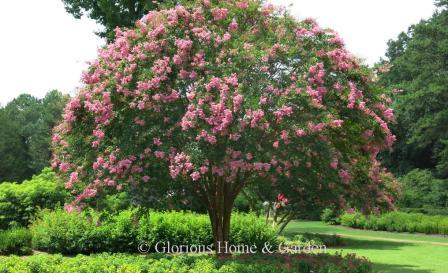 Lagerstroemia x 'Osage'
Lagerstroemia x 'Osage'Summer flowering trees are the more welcome simply because there are fewer of them. Sure, we look forward to and enjoy the spectacular spring bloomers—the cherries, the redbuds, the dogwoods, the magnolias--but there are still a surprisingly number of good choices we can make for the summer garden. Some are very well known, and others deserve a wider planting, and some are better suited for some zones than others. Be sure to include one or two summer flowering trees in your garden to fill in gaps or to extend the season. Many of them have multi-season appeal with spectacular autumn colors or beautiful bark for winter interest in addition to the flowers.
Clerodendrum trichotomum, harlequin glorybower, Zones 7-10. Of all the summer flowering trees, harlequin glorybower is one of the most unusual. Not only does it bloom at the end of summer, but the white flowers are followed by curious blue fruits with red calyxes that add to the ornamental value. Crushed leaves are said to have the odor of peanut butter. Harlequin glorybower grows to a rather ungainly suckering shrub, but can be trained to a single trunk and will attain 10-20.’ Does best in full sun with adequate moisture.
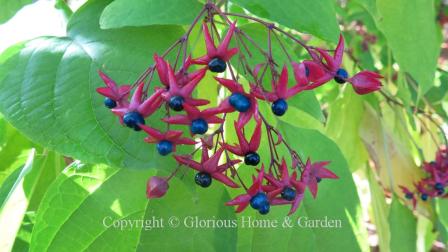 Clerodendrun trichotomum
Clerodendrun trichotomumCornus angustata, evergreen Chinese dogwood, Zones 6-9. I love dogwoods, and I hate to see the bloom season come to an end each year. I want to extend it as long as possible by having a good selection of dogwoods from C. mas to C. florida to C. kousa, but after the kousas that's it until next year. Well, there is one more lovely dogwood to add to extend the bloom season into early summer-- the evergreen Chinese dogwood, particularly a cultivar called 'Empress of China.' Developed by John Elsley of Wayside Gardens, it is now becoming more widely available. Some of the leaves turn a brilliant shade of crimson in the fall, but the rest remain until new ones push them off in the spring. Mine blooms in mid-June, and the blooms are followed by red fruits (similar to kousas, but smaller). The individual blooms are kousa-like also and the four white bracts tend to recurve. I understand they can grow to about 18' high and about 15' wide. A new garden star!
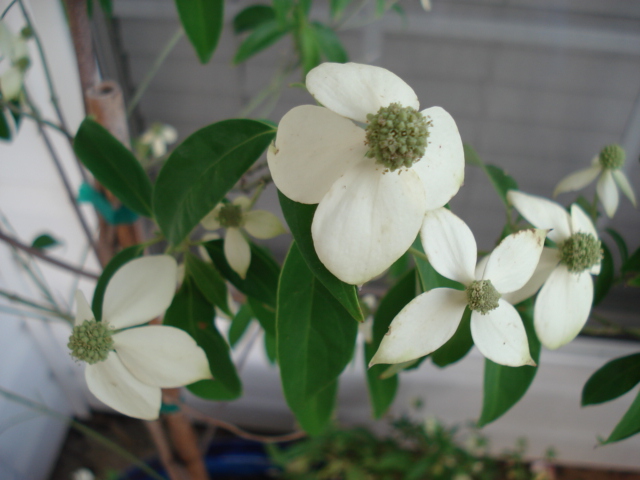 Cornus angustata 'Empress of China'
Cornus angustata 'Empress of China'Franklinia alatamaha, franklinia, Zones 5-8. Plant explorer John Bartram saved this plant from extinction when he discovered it near the Altamaha River in Georgia in 1770 and collected seed. Named for Benjamin Franklin, it has not been found the wild since. It is a very interesting small tree not only because of its history, but because its white flowers resembling single white camellias appear in mid-summer, followed by brilliant red fall foliage color.
Heptacodium miconioides, seven-son flower, Zones 5-8. The creamy white fragrant flowers are borne in long panicles in late summer followed by showy red calyxes. The bark exfoliates as well. Good butterfly plant. Useful as a specimen grown as a large multi-stemmed shrub or trained as a single trunk tree.
Koelreuteria bipinnata, bougainvillea goldenrain tree, Zones 6-8. This is a lovely tree that blooms in late summer with long panicles of yellow followed by puffy, pinkish seedpods that look like little Chinese lanterns.
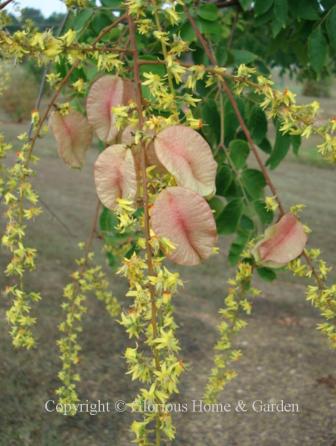 Koelreuteria bipinnata
Koelreuteria bipinnataKoelreuteria paniculata, panicled goldenrain tree, Zones 5-8. Panicled goldenraintree is similar to K. bipinnata, but blooms in late spring/early summer depending on locality with brown rather than pinkish seedpods.
Lagerstroemia fauriei, Japanese crape myrtle, Zones 6b-10a. I fell in love with this species of crape myrtle when I saw a champion specimen at the J. C. Raulston Arboretum in Raleigh. It was the cultivar ‘Fantasy,’ and the bark was a beautiful mottled reddish-brown. So, I succumbed to plant lust and bought one at the annual Trees Atlanta plant sale in 2013. It was small and lived in its pot for a couple of years because I knew I was going to move and did not want to leave it behind. Well, it finally got planted and immediately took off and is doing very well. It is currently about 12’ tall (2020), and can eventually reach 35-50’. The white flowers began to appear and the bark began to exfoliate in 2019. The flower trusses are not as large or as full as on Lagerstroemia indica varieties, but are beautiful nonetheless, and the foliage turns a golden yellow in the fall.
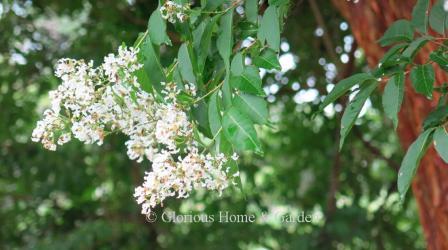 Lagerstroemia fauriei 'Fantasy' in bloom
Lagerstroemia fauriei 'Fantasy' in bloomLagerstroemia indica, crape myrtle, Zones 7-9. Often called the "lilac of the South" for its large trusses of flowers, though, unfortunately, not fragrant. But the long period of colorful, showy blooms justifies the extensive use of this plant in the South, as well as the exfoliating bark and intensive fall leaf colors. Landscapers love to whack them back severely to stumps in the late winter (known as “crape murder”), but they are much more attractive grown to accentuate their natural forms. All that is really needed is to remove the spent flowerheads at season's end. One of the loveliest uses I have seen is the allée of 'Natchez' at the Atlanta Botanical Garden, grown tall as multi-stemmed trees and arching over the walk. There are many cultivars of various sizes in colors ranging from white to many shades of pink, coral, magenta, dark red, and lavender. There are also new dwarf varieties that fit well into smaller gardens, and even some with dark, nearly black foliage.
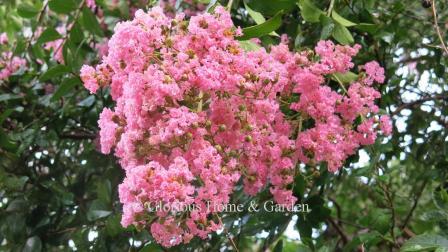 Lagerstroemia indica 'Choctaw'
Lagerstroemia indica 'Choctaw'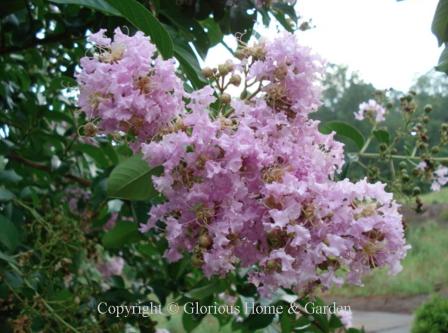 Lagerstroemia indica 'Lipan'
Lagerstroemia indica 'Lipan'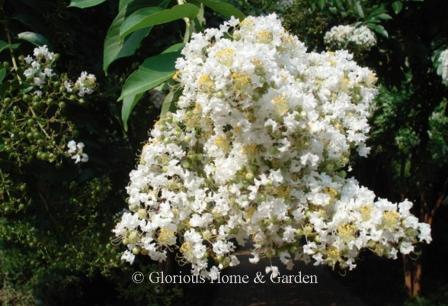 Lagerstroemia indica 'Natchez'
Lagerstroemia indica 'Natchez'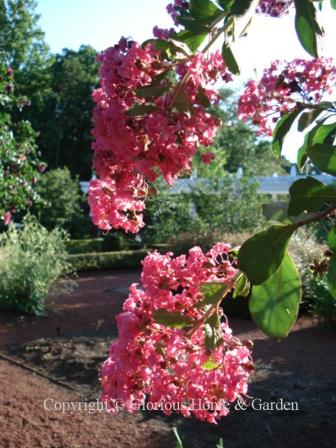 Lagerstroemia indica 'Watermelon Red'
Lagerstroemia indica 'Watermelon Red'Magnolia virginiana, sweetbay magnolia, Zones 5-9. One of the loveliest of our native Eastern U.S. trees, sweetbay blooms in May and sporadically throughout the summer. The white flowers, though smaller than M. grandiflora, are very sweetly scented, so it is nice to plant near a patio where they can be appreciated. This is also a good choice for areas with wet soils and partial shade.
'Moonglow' (also known as 'Jim Wilson') has creamy flowers and an upright growth habit to 15-35'.
 Magnolia virginiana 'Moonglow'
Magnolia virginiana 'Moonglow'Oxydendrum arboreum, sourwood or lily-of-the-valley tree, Zones 5-9. One of the loveliest of our native trees, sourwood has multi-season interest. Panicles of white urn-shaped flowers appear in summer giving it its other common name, lily-of-the-valley tree. Bees love it and sourwood honey is made from it. After flowering, the dried seed capsules make the tree look like it’s still in bloom. The fall leaf color is outstanding turning crimson to purple.
Stewartia koreana, Korean stewartia, Zones 5-7. White flowers resembling a camellia on a small tree with gorgeous exfoliating bark and outstanding fall color. A specimen tree for a special location.
Stewartia pseudocamellia, Japanese stewartia, Zones 5-8. This species from Japan is another outstanding selection for use as a specimen in the garden. It has white flowers in summer and like S. korena, beautiful mottled bark in shades of brown and gray, as well as excellent fall color. Stewartias require full sun but afternoon shade in hot climates and rich, acidic, humusy soil that is consistently moist, but well-drained.
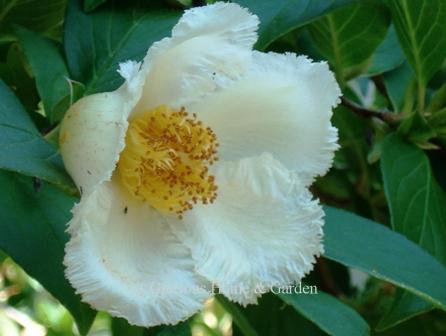 Stewartia pseudocamellia
Stewartia pseudocamelliaTilia cordata, littleleaf linden, Zones 3b-7. This is a wonderful shade tree for many uses as it tolerates pollution and city conditions well. One of its chief attributes is that it flowers in early summer with dangling fragrant yellow flowers that bees go nuts over.
Vitex agnus-castus, vitex or chastetree, Zones 6-9. A nice summer blooming tree, vitex produces long, narrow panicles of bloom in shades of lavender at a time when there are few other trees in bloom. It makes a nice specimen or border reaching anywhere from 10’ to 20’ h. depending on location. In northerly zones, it may die back to the ground in winter and is therefore treated like a herbaceous perennial.
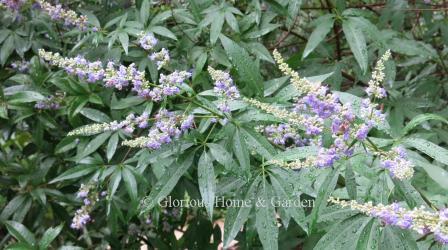 Vitex agnus-castus
Vitex agnus-castusPlant of the Month
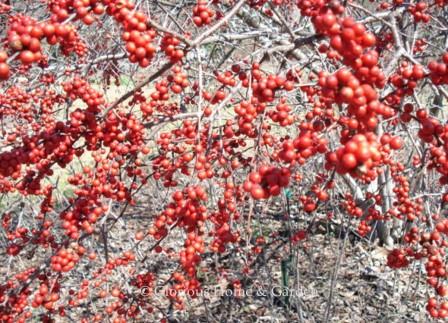
Ilex verticillata
Winterberry holly
Updated new USDA Plant Hardiness Zone Map 2023.